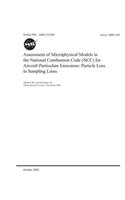
Assessment of Microphysical Models in the National Combustion Code (Ncc) for Aircraft Particulate Emissions
Series:
This paper at first describes the fluid network approach recently implemented into the National Combustion Code (NCC) for the simulation of transport of aerosols (volatile particles and soot) in the particulate sampling systems. This network-based approach complements the other two approaches already in the NCC, namely, the lower-order temporal approach and the CFD-based approach. The accuracy and
NaN
VOLUME
English
Paperback

This paper at first describes the fluid network approach recently implemented into the National Combustion Code (NCC) for the simulation of transport of aerosols (volatile particles and soot) in the particulate sampling systems. This network-based approach complements the other two approaches already in the NCC, namely, the lower-order temporal approach and the CFD-based approach. The accuracy and the computational costs of these three approaches are then investigated in terms of their application to the prediction of particle losses through sample transmission and distribution lines. Their predictive capabilities are assessed by comparing the computed results with the experimental data. The present work will help establish standard methodologies for measuring the size and concentration of particles in high-temperature, high-velocity jet engine exhaust. Furthermore, the present work also represents the first step of a long term effort of validating physics-based tools for the prediction of aircraft particulate emissions. Wey, Thomas and Liu, Nan-Suey Glenn Research Center NASA/TM-2008-215304, AIAA Paper-2009-0257, E-16575
Price Comparison [India]
In This Series
Bestseller Manga
Trending NEWS




















